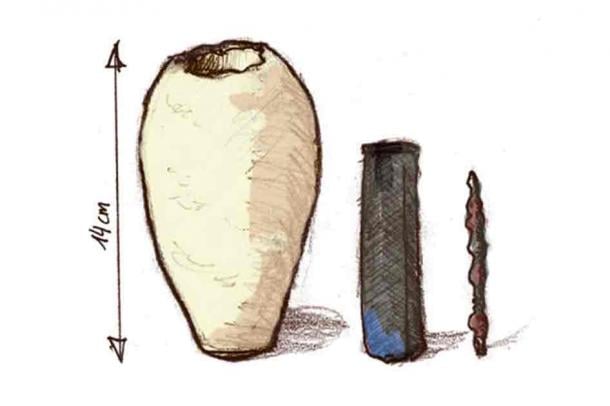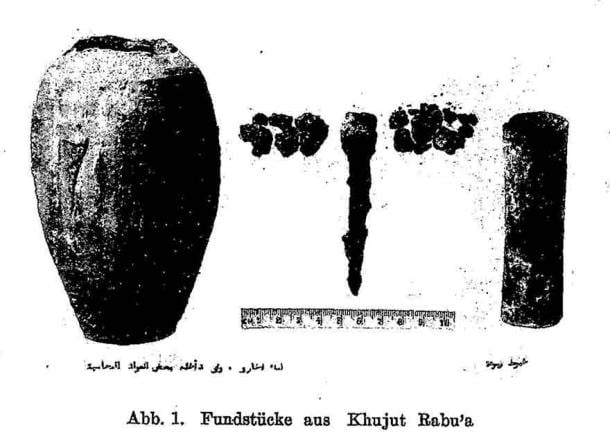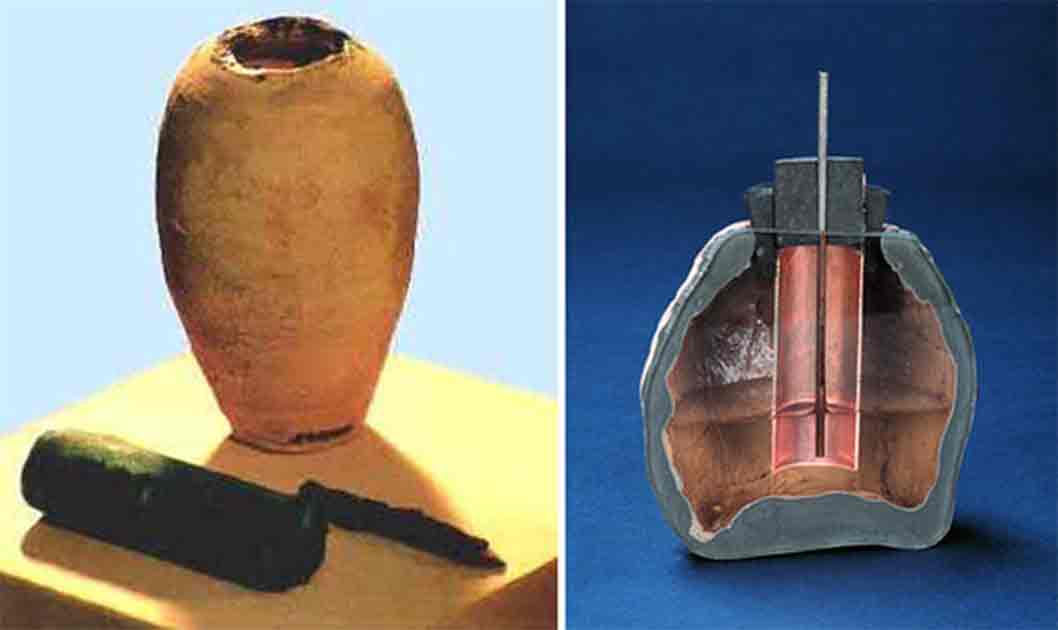Decoding the Baghdad Battery: Ancient Artifact or Medical Marvel?
Longstanding beliefs about ancient technological and medical knowledge were placed under scrutiny when Paul T. Keyser's published an article in the 1990s challenging the conventional narrative of ancient technological and medical ignorance. Writing in the Journal of Near Eastern Studies, Keyser proposed that ancient batteries and electric eels might have been utilized for medical purposes, potentially for pain relief or anesthesia.
This hypothesis raises intriguing questions about the true function of the Baghdad Battery, a mysterious artifact from antiquity. As archaeological and textual evidence continues to emerge, scholars are reevaluating our understanding of ancient civilizations and their capabilities in technology and medicine.

Drawing of the Baghdad Battery. (Ironie / CC BY-SA 2.5)
Debating the Purpose of the “Baghdad Battery”
The Baghdad Battery, sometimes referred to as the Parthian Battery, is a clay pot which encapsulates a copper cylinder. Suspended in the center of this cylinder—but not touching it—is an iron rod. Both the copper cylinder and the iron rod are held in place with an asphalt plug.
These artifacts (more than one so-called “Baghdad Battery” was found) were discovered during the 1936 excavations of the old village Khujut Rabu, near Baghdad in Iraq. The village is considered to be about 2,000 years old and was built during the Parthian period which dates back to between 250BC and 224 AD. For some, the Baghdad Battery is thought to provide insight into ancient Mesopotamian technology.
- Ten Amazing Artifacts from the Ancient World
- Common Tools or Ancient Advanced Technology? How Did the Egyptians Bore Through Granite?
The Baghdad Battery remains a contentious topic in archaeological circles, with established academia viewing it with skepticism as more likely a mundane artifact than an ancient electrical device. While prevailing opinion leans towards conventional uses such as storage, alternative historians and enthusiasts of ancient mysteries find its enigmatic nature captivating, proposing speculative theories about its potential as a primitive electrical device or for electroplating.

The Baghdad Battery which was discovered in Iraq. (Lenny Flank / CC BY-NC-SA 2.0 DEED)
Uncovering the Potential of the Baghdad Battery: Keyser's Hypothesis
According to Keyser, ancient Akkad and Babylon employed two types of physicians. The Asipu diagnosed the patient’s ailment through divination or observing the symptoms, while the Asu prescribed the treatment of either medicines or incantations. Keyser theorizes that the Asu may have applied electric currents to the patient to treat the affected area.
While one battery would not have been able to generate enough voltage to deaden skin, several linked together, would. According to Keyser, “Mesopotamian medical practice included a number of elements conducive to the reception of an electrotherapeutic device of this sort.”
When the electric Baghdad Battery was first discovered, the find wasn’t readily shared because the unusual artifact didn’t fit the “ignorance paradigm” of ancient civilizations. But as continued Parthian excavations uncovered more batteries, the curious phenomenon persisted.
Skeptics of the so-called battery claim the small vessel is nothing more than a jar for storing papyrus. Others say it was used for electroplating. But if it was used for electroplating, why were no electroplated objects discovered?
Some researchers believe the presence of asphalt, used as a sealant, and the corrosive properties inside the jar, prove that the contraption once contained a caustic liquid. In ancient times, acidic substances were common, with vinegar or wine being likely candidates for the corroding liquid housed in the Baghdad Battery.Top of FormBottom of Form
Keyser suggested that bronze and iron needles, unearthed alongside the batteries in Seleucia, an ancient city near Baghdad, could have been utilized for acupuncture, a practice widespread in China during that era. Moreover, other ancient civilizations, like the Greeks and Romans, are thought to have employed electric fish for treating ailments such as headaches and gout.
Scribonius Largus, a prominent Roman physician of the 1st century AD, left a fascinating account of ancient medical practices. In his writings, he prescribed an unconventional remedy for foot gout: placing a living black torpedo fish—also known as an electric ray—and renowned for its ability to produce electric shocks, under the feet of the afflicted individual while standing on a beach. Largus advised that the fish should be positioned in a spot where the sea washes over it, causing the affected area to become numb up to the knees.
Keyser proposes that since electric fish are not found in the Persian Gulf or Mesopotamian rivers, ancient peoples may have created the Baghdad Battery as an alternative means to harness electricity. This theory offers a new perspective on ancient technological innovation.

A type of electric ray, able to produce electric shocks. The ancient Greeks and Romans are thought to have used electric fish in their healing methods. (Public domain)
Challenging the Narrative: Revisiting the Baghdad Battery
This theory isn’t popular with scholars because such advanced knowledge doesn’t fit their evolutionary theory of humankind that purports Homo sapiens evolved from primitive, unintelligent ape-men instead of intelligent, creatively thinking and inventive humans. Such “Out of Place ARTifactS” (OOPARTS) were written about by Rene Noorbergen in his 1970s book, Secrets of the Lost Races. Noorbergen’s book was (and is) highly controversial, sparking considerable debate within academia and beyond.
A simple Google search reveals countless unexplained relics suggesting advanced civilizations. However, because they don't align with the academic paradigm, they're often dismissed as nonsense or frauds.
Nevertheless, times are changing. With the proliferation of online media and television shows, people are becoming increasingly curious and eager to embrace out-of-the-box theories. Whether it's copper arrowheads discovered 400 feet (122 m) below the surface in Colorado or the exquisite Dorchester Pot, long-held theories demand re-examination. Even though people lived in caves, it's plausible that, then as now, ancient people coexisted with advanced technology.
DNA evidence itself points to mankind becoming weaker (and perhaps dumber?) rather than stronger over time. “We are a perishing people living in a dying world,” wrote Dr. John Sanford of Cornell University. “The extinction of the human genome appears to be just as certain and deterministic as the extinction of stars, the death of organisms, and the heat death of the universe.” So, if it is true that humankind is deteriorating, does it make sense we started out dumber than we are now?
- Lighting Up Saqqara: An Electrifying Theory for the Serapeum Sarcophagi
- These are Among the Biggest Archaeological Discoveries in History
Granted, the physical evidence of how intelligent humans were is lacking because of their circumstances. Most of their tools have turned to dust. Perhaps this doesn’t point to the ignorance of Homo sapiens in the past as much as it does to the modern-day existence of narrow-minded academics who fail to interpret evidence in the context of human behavior.
What should ancient humankind have known? Only by asking these questions in the framework of their day-to-day lives can researchers learn and interpret OOPARTS correctly. In the milieu of ancient medicine, whereby other civilizations used electric sea creatures to treat their ailments, it is a plausible theory the Baghdad Battery was an electrotherapeutic device. Sadly, the war in Iraq did serious damage to the National Museum and many of these batteries have gone missing.
A prophetic article published by BBC News in 2003, delved into the mystery surrounding the Baghdad batteries, potentially the earliest known batteries in the world. “War can destroy more than a people, an army or a leader. Culture, tradition and history also lie in the firing line. Iraq has a rich national heritage. The Garden of Eden and the Tower of Babel are said to have been sited in this ancient land. In any war, there is a chance that priceless treasures will be lost forever, articles such as the “ancient battery” that resides defenseless in the museum of Baghdad.”
Top image: Replica of the Baghdad Battery. Source: Researchgate/ CC BY-SA 3.0
By Karla Akins
References
BBC News. 27 February 2003. “Riddle of ‘Baghdad’s batteries’” in BBC News. Available at: http://news.bbc.co.uk/2/hi/science/nature/2804257.stm
Elvindukebox. 9 June 2008. “MythBusters – The Dirtiest Trick in Mythbuster History” in YouTube. Available at: https://www.youtube.com/watch?v=U0SEBFGGEcI
IanW. No date. “Building a Baghdad Battery” in Autodesk Instructables. Available at: https://www.instructables.com/Building-a-quotBaghdad-Batteryquot/
Jones, C. 18 August 2011. “Electricity in the Ancient World” in Gates of Nineveh. Available at: https://gatesofnineveh.wordpress.com/2011/08/18/electricity-in-the-ancient-world/
Keyser, P. T. April 1993. “The Purpose of the Parthian Galvanic Cells: A First-Century A. D. Electric Battery Used for Analgesia” in Journal of Near Eastern Studies, Vol. 52, No. 2, pp. 81-98. Available at: https://www.jstor.org/stable/545563
Nobigbang. 4 November 2011. “Dr John Sanford on Genetic Entropy” in YouTube. Available at: https://www.youtube.com/watch?v=VzHPqfJrIjE
PindzMedia29. 22 December 2010. “Ancient Baghdad Battery IRAQ” in YouTube. Available at: https://www.youtube.com/watch?v=8Evm9hTWYxQ
Stanford, J. C. 2005. Genetic Entrophy & the Mystery of the Genome. Ivan Press.


















Comments
You know that there are several items like the Baghdad Battery but only one of them is actually capable of providing electric power? That's why I believe that the number of persons who understood this gadget was extremely limited, more than a use for medical purposes would suggest.
The other known specimens may in fact have been failed attempts to "pirate" the Baghdad Battery, I guess. For that reason we gave it in our "Romanike" novels (described on http://www.corpus-sacrum.de) to a skilled alchemist, not to a healer, who uses them to plate items with gold, seemingly by magic, and who treats their mode of operation as a trade secret whose discovery is a plot device.
this is sopposed to help us right? Then why isn't it helping me
*Ronald* Mallet
"but perhaps then as now, they lived in them alongside advanced civilizations"
I have been thinking this as well. We have primitive people living with us today.
Here is a question that needs to be addressed: How long does a group of people need to create a civilization?
Not long I bet. Not nearly as long as the popular theories suggest.
Given resources, towns and cities seem to pop up fast. However, these groups seem to be fragile, look at the populations in North America when Europeans arrived compared to just a few centuries before. Things change quickly, fortunes rise and fall.
I struggle with the need to apply answers to the "why" of situations. Was it a temple? who cares, we will never know. Is it a great building with expert masonry and astronomical alignments, yes, that we can test and confirm. It is something we can know as fact.
Applying this line of reasoning to the "batteries" tells us that they used dissimilar metals and kept them from touching. Fascinating facts in and of themselves. The exact function may never be known, How it was used will not likely be discovered until we get Robert Mallett's time machine working.
mr32953
I always find it fascinating to take a look at what sort of ancient technologies were being developed in the Middle East during Jesus/Yeshua' time. This might sound rather odd at first, but one cannot help but wonder if Jesus/Yeshua had ever had the opportunity to either learn of the device or even see it for himself. After all, the device was discovered only a few weeks' travel from Galilee, and even if Jesus/Yeshua didn't have the opportunity to travel to Baghdad himself (think the "missing years"), the likelihood that one or more of the Baghdad Batteries might have been brought to either the popular Galilean trading city of Sepphoris or Jerusalem via ancient trade routes is within the scope of possibility.
JB Richards
Author of "Miriamne the Magdala"- The first chapter in the "Yeshua and Miri Novel Series" and Content Creator for The Miriamne Page
For more information on this epic novel series, and The Miriamne Page, just click on this link: https://www.facebook.com/pages/Miriamne-the-Magdala-First-in-the-Series-...